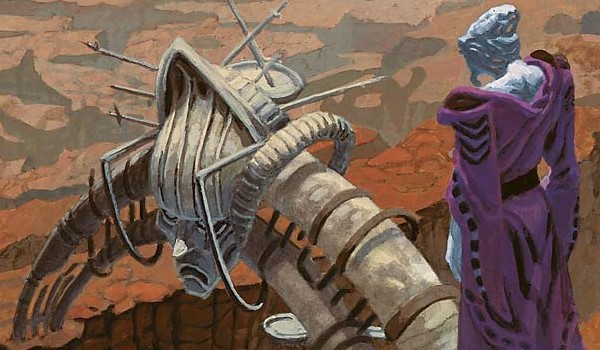Are you a Quiet Speculation member?
If not, now is a perfect time to join up! Our powerful tools, breaking-news analysis, and exclusive Discord channel will make sure you stay up to date and ahead of the curve.
Hello everybody, and welcome to a new installment of Magical Creatures. In this series, we comprehensively analyze each creature type specific to the Magic universe. With every piece comes an expansion. We started with Antiquities, and last time, discussed the new types introduced with Mirage.
Mirage was the first expansion in a three-set block, but we won't touch the other two (Visions and Weatherlight). Even though they both introduced several new creature types (such as Chimera and Jellyfish), none were unique to this game. Sorry, Avizoa fans!
Today, we'll jump straight into Tempest, from 1997. The last set of that year was also the first set in the Rath cycle (followed by smaller sets Stronghold and Exodus, both from 1998). Tempest introduced no less than 5 new creature types unique to the Magic: The Gathering franchise, even though a few clarifications need to be made. But first, let's take a look at the set itself, and see what it brought to the game.
Tempest and the Rath Cycle
Released in October 1997, Tempest is the 12th Magic set. Its 350 cards were not only sold in starter decks and booster packs, but also in preconstructed decks. The set's new mechanics were buyback and shadow. The first one was not all that successful, although it did contribute to a very strong card in Sprout Swarm (discussed in detail a few weeks ago alongside Thrulls, Homarids and Saprolings). The second one is just another evasive ability, like flying and fear, but only ever appeared in the Rath cycle, excluding a few exceptions.
But what about the new creature types? Tempest introduced Crab and Shapeshifter, which we won't take into account since they are not specific to this game. But it also introduced Licid, Spike, and notably, one of the most prolific and beloved creature types of all time!
Subtypes Added Retroactively
Wait... three? Didn't I say five? The fact is the other two types (Soltari and Thalakos) did not exist right away. They were retroactively added with the advent of Time Spiral. For instance, neither Soltari Priest nor Thalakos Sentry featured the relevant subtype on paper, although their races appeared in the name of the cards. At least, not in their original version from Tempest. Something similar would happen again with the subtype Kor, which we'll circle back to in a future article.
Since five new types is quite a lot, and given that the final tribe is especially storied, we'll split this set into two separate articles. Today's will discuss Soltari and Thalakos, while next week's will focus on the others.
Soltari
Soltari is a white creature type not unlike Spirit. Its creatures are all white, with the lone exception of Soltari Guerillas being both white and red. They all feature the keyword shadow. Lastly, they all come from the Rath cycle. Only ten cards exist with this creature type: eight from Tempest, one from Stronghold, and one from Exodus. No more Soltari were printed, apart from a reprint of Soltari Priest in Time Spiral and a couple more reprints in Vintage Masters.
All in, the Soltari tribe looks proves quite consistent. They are all low-curve white creatures that make for decent beaters, especially considering shadow. None of them has ever been particularly successful, at least in the competitive environment. However, shadow can be a popular keyword with casual players, and there are enough Soltari in existence to make a tribal deck.
Thalakos
Thalakos is something of a blue analogue to Soltari, as they also represent Spirit-like beings and its cards have shadow. They are basically shadow creatures trapped on the plane of Rath. Only seven cards exist with this subtype, and they again all come from the Rath cycle: four from Tempest, one from Stronghold, and two from Exodus.
It's another consistent tribe, but if I must be honest, they are not that interesting. The only aspect that differentiates them from the Soltari is their sneaky quality, which is in line with blue's color pie identity. Apart from that, they are just another shade of shadow creature, caught between the planes, and not really able to interact with the world at large.
They shadow keyword prevents all these creatures from being blocked by creatures without shadow, but it also prevents them from blocking creatures that don't have shadow. While flavorful when it comes to illustrating a creature caught between planes, the absence of interaction has never been good on a Magic card. That's why most people despise combo decks, especially those not allowing the opponent any kind of counterplay. And that's why some of them were banned (think of the infamous deck Eggs). Even newer players often grimace when met with a creature that "can't be blocked," as such texts suppresses a key element of the game.
Two Colours, One Fate
Initially, these creatures could be identified as Soltari and Thalakos solely because those respective tribes appeared in their names, but they didn't actually carry those subtypes. Things changed with the Grand Creature Type Update, as has become a theme in this series!
The only difference is that Soltari got the subtype a year earlier than Thalakos, since Time Spiral (2006) reprinted Soltari Priest. Its typeline read not Summon Cleric, but rather Creature – Soltari Cleric. Poor Thalakos had to wait until Lorwyn (2007).
Do you have a preference between these two oft-forgotten tribes? Have you ever sleeved one up? Let me know in the comments or on Twitter, and stay tuned for next piece, where we'll do a 180 and dive into one of Magic's most beloved creature types... Sliver!




